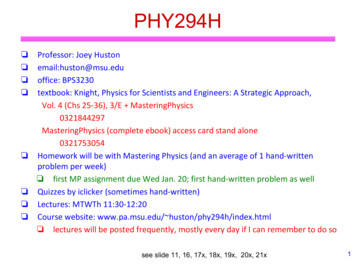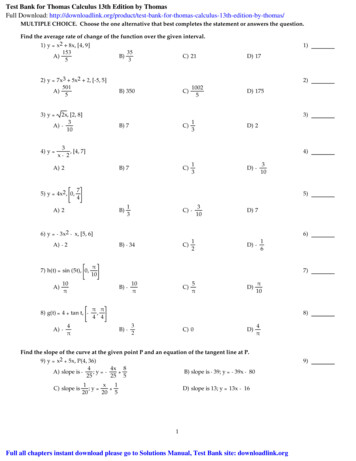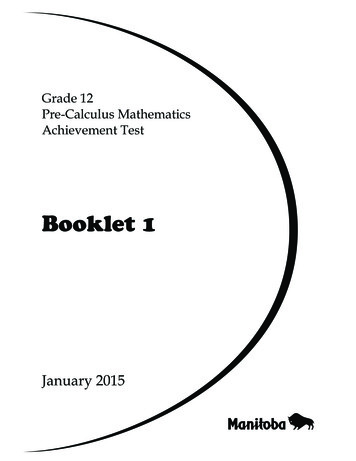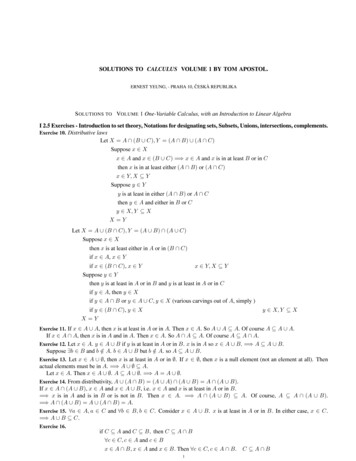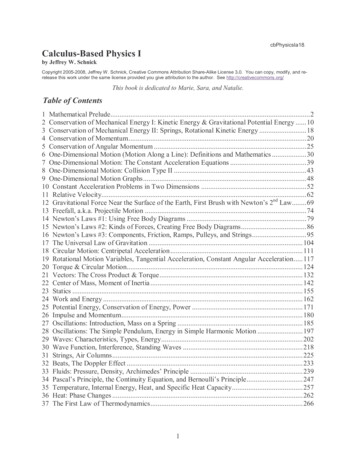
Transcription
Chapter 1 Mathematical PreludecbPhysicsIa18.docCalculus-Based Physics Iby Jeffrey W. SchnickCopyright 2005-2008, Jeffrey W. Schnick, Creative Commons Attribution Share-Alike License 3.0. You can copy, modify, and rerelease this work under the same license provided you give attribution to the author. See http://creativecommons.org/This book is dedicated to Marie, Sara, and Natalie.Table of Contents1 Mathematical Prelude.22 Conservation of Mechanical Energy I: Kinetic Energy & Gravitational Potential Energy .103 Conservation of Mechanical Energy II: Springs, Rotational Kinetic Energy .184 Conservation of Momentum.205 Conservation of Angular Momentum .256 One-Dimensional Motion (Motion Along a Line): Definitions and Mathematics .307 One-Dimensional Motion: The Constant Acceleration Equations .398 One-Dimensional Motion: Collision Type II .439 One-Dimensional Motion Graphs.4810 Constant Acceleration Problems in Two Dimensions .5211 Relative Velocity.6212 Gravitational Force Near the Surface of the Earth, First Brush with Newton’s 2nd Law.6913 Freefall, a.k.a. Projectile Motion .7414 Newton’s Laws #1: Using Free Body Diagrams .7915 Newton’s Laws #2: Kinds of Forces, Creating Free Body Diagrams.8616 Newton’s Laws #3: Components, Friction, Ramps, Pulleys, and Strings.9517 The Universal Law of Gravitation .10418 Circular Motion: Centripetal Acceleration .11119 Rotational Motion Variables, Tangential Acceleration, Constant Angular Acceleration.11720 Torque & Circular Motion.12421 Vectors: The Cross Product & Torque.13222 Center of Mass, Moment of Inertia .14223 Statics .15524 Work and Energy .16225 Potential Energy, Conservation of Energy, Power .17126 Impulse and Momentum.18027 Oscillations: Introduction, Mass on a Spring .18528 Oscillations: The Simple Pendulum, Energy in Simple Harmonic Motion .19729 Waves: Characteristics, Types, Energy.20230 Wave Function, Interference, Standing Waves .21831 Strings, Air Columns.22532 Beats, The Doppler Effect .23333 Fluids: Pressure, Density, Archimedes’ Principle .23934 Pascal’s Principle, the Continuity Equation, and Bernoulli’s Principle.24735 Temperature, Internal Energy, Heat, and Specific Heat Capacity.25736 Heat: Phase Changes .26237 The First Law of Thermodynamics.2661
Chapter 1 Mathematical Prelude1 Mathematical PreludeJust below the title of each chapter is a tip on what I perceive to be the mostcommon mistake made by students in applying material from the chapter. Iinclude these tips so that you can avoid making the mistakes. Here’s the first one:1 1 is not x y. Try it in the case of some simple numbers.The reciprocal ofx y1 11 12 13 Suppose x 2 and y 4. Then and the reciprocalx y2 44 4434ofiswhich is clearly not 6 (which is what you obtain if you take the431 11 1 ? Thereciprocal of to be 2 4). So what is the reciprocal of2 4x y1 11 isreciprocal of.1 1x y x yThis book is a physics book, not a mathematics book. One of your goals in takinga physics course is to become more proficient at solving physics problems, bothconceptual problems involving little to no math, and problems involving somemathematics. In a typical physics problem you are given a description aboutsomething that is taking place in the universe and you are supposed to figure outand write something very specific about what happens as a result of what istaking place. More importantly, you are supposed to communicate clearly,completely, and effectively, how, based on the description and basic principles ofphysics, you arrived at your conclusion. To solve a typical physics problem youhave to: (1) form a picture based on the given description, quite often a movingpicture, in your mind, (2) concoct an appropriate mathematical problem based onthe picture, (3) solve the mathematical problem, and (4) interpret the solution ofthe mathematical problem. The physics occurs in steps 1, 2, and 4. Themathematics occurs in step 3. It only represents about 25% of the solution to atypical physics problem.You might well wonder why we start off a physics book with a chapter on mathematics. Thething is, the mathematics covered in this chapter is mathematics you are supposed to alreadyknow. The problem is that you might be a little bit rusty with it. We don’t want that rust to getin the way of your learning of the physics. So, we try to knock the rust off of the mathematicsthat you are supposed to already know, so that you can concentrate on the physics.As much as we emphasize that this is a physics course rather than a mathematics course, there isno doubt that you will advance your mathematical knowledge if you take this course seriously.You will use mathematics as a tool, and as with any tool, the more you use it the better you get atusing it. Some of the mathematics in this book is expected to be new to you. The mathematicsthat is expected to be new to you will be introduced in recitation on an as-needed basis. It isanticipated that you will learn and use some calculus in this course before you ever see it in amathematics course. (This book is addressed most specifically to students who have never had a2
Chapter 1 Mathematical Preludephysics course before and have never had a calculus course before but are currently enrolled in acalculus course. If you have already taken calculus, physics, or both, then you have a wellearned advantage.)Two points of emphasis regarding the mathematical component of your solutions to physicsproblems that have a mathematical component are in order:(1) You are required to present a clear and complete analytical solution to each problem. Thismeans that you will be manipulating symbols (letters) rather than numbers.(2) For any physical quantity, you are required to use the symbol which is conventionally usedby physicists, and/or a symbol chosen to add clarity to your solution. In other words, it isnot okay to use the symbol x to represent every unknown.Aside from the calculus, here are some of the kinds of mathematical problems you have to beable to solve:Problems Involving Percent ChangeA cart is traveling along a track. As it passes through a photogate1 its speed is measured to be3.40 m/s. Later, at a second photogate, the speed of the cart is measured to be 3.52 m/s. Find thepercent change in the speed of the cart.The percent change in anything is the change divided by the original, all times 100%. (I’veemphasized the word “original” because the most common mistake in these kinds ofproblems is dividing the change by the wrong thing.)The change in a quantity is the new value minus the original value. (The most commonmistake here is reversing the order. If you forget which way it goes, think of a simpleproblem for which you know the answer and see how you must arrange the new andoriginal values to make it come out right. For instance, suppose you gained 2 kg over thesummer. You know that the change in your mass is 2 kg. You can calculate thedifference both ways—we’re talking trial and error with at most two trials. You’ll quicklyfind out that it is “the new value minus the original value” a.k.a. “final minus initial” thatyields the correct value for the change.)Okay, now let’s solve the given problem% Change change100 %original(1-1)Recalling that the change is the new value minus the original value we have1A photogate is a device that produces a beam of light, senses whether the beam is blocked, and typically sends asignal to a computer indicating whether the beam is blocked or not. When a cart passes through a photogate, ittemporarily blocks the beam. The computer can measure the amount of time that the beam is blocked and use thatand the known length of the cart to determine the speed of the cart as it passes through the photogate.3
Chapter 1 Mathematical Prelude% Change new original100 %original(1-2)While it’s certainly okay to memorize this by accident because of familiarity with it, youshould concentrate on being able to derive it using common sense (rather than working atmemorizing it).Substituting the given values for the case at hand we obtain3.52% Change mm 3.40ss 100%m3.40s% Change 3.5%Problems Involving Right TrianglesExample 1-1: The length of the shorter side of a right triangle is x and the length of thehypotenuse is r. Find the length of the longer side and find both of the angles, asidefrom the right angle, in the triangle.Solution:rϕxDraw the triangle such that it is obviouswhich side is the shorter sideθyPythagorean TheoremSubtract x 2 from both sides of the equationSwap sidesTake the square root of bothsides of the equationBy definition, the sine of θ is the sideopposite θ divided by the hypotenuseTake the arcsine of both sides of theequation in order to get θ by itselfr2 x2 y2r 2 x2 y2y2 r 2 x2y r 2 x2sin θ xrθ sin 1By definition, the cosine of ϕ is the sideadjacent to ϕ divided by the hypotenuseTake the arccosine of both sides of theequation in order to get ϕ by itself4cos ϕ xrxrϕ cos 1xr
Chapter 1 Mathematical PreludeHypotenuseTo solve a problem like the one above, you needto memorize the relations between the sides andthe angles of a right triangle. A convenientmnemonic2 for doing so is “SOHCAHTOA”pronounced as a single word.OppositeθAdjacentReferring to the diagram above right:SOH reminds us that: sin θ OppositeHypotenuse(1-3)CAH reminds us that: cos θ AdjacentHypotenuse(1-4)OppositeAdjacent(1-5)TOA reminds us that: tan θ Points to remember:1. The angle θ is never the 90 degree angle.2. The words “opposite” and “adjacent” designate sides relative to the angle. For instance,the cosine of θ is the length of the side adjacent to θ divided by the length of thehypotenuse.You also need to know about the arcsine and the arccosine functions to solve the exampleproblem above. The arcsine function is the inverse of the sine function. The answer to thequestion, “What is the arcsine of 0.44?” is, “that angle whose sine is 0.44 .” There is an arcsinebutton on your calculator. It is typically labeled sin-1, to be read, “arcsine.” To use it youprobably have to hit the inverse button or the second function button on your calculator first.The inverse function of a function undoes what the function does. Thus:sin 1 sin θ θ(1-6)Furthermore, the sine function is the inverse function to the arcsine function and the cosinefunction is the inverse function to the arccosine function. For the former, this means that:sin (sin 1 x ) x2A mnemonic is something easy to remember that helps you remember something that is harder to remember.5(1-7)
Chapter 1 Mathematical PreludeProblems Involving the Quadratic FormulaFirst comes the quadratic equation, then comes the quadratic formula. The quadratic formula isthe solution to the quadratic equation:a x 2 bx c 0(1-8)in which:x is the variable whose value is sought, anda, b, and c are constantsThe goal is to find the value of x that makes the left side 0. That value is given by the quadraticformula:x b b 2 4ac2a(1-9)to be read/said:‘x’ equals minus ‘b’, plus-or-minus the square root of ‘b’ squaredminus four ‘a’ ‘c’, all over two ‘a’.So, how do you know when you have to use the quadratic formula? There is a good chance thatyou need it when the square of the variable for which you are solving, appears in the equationyou are solving. When that is the case, carry out the algebraic steps needed to arrange the termsas they are arranged in equation 1-8 above. If this is impossible, then the quadratic formula isnot to be used. Note that in the quadratic
zeroth power (the constant term). If additional powers also appear, such as the one-half power (the square root), or the third power, then the quadratic formula does not apply. If the equation includes additional terms in which the variable whose value is sought appears as the argument of

